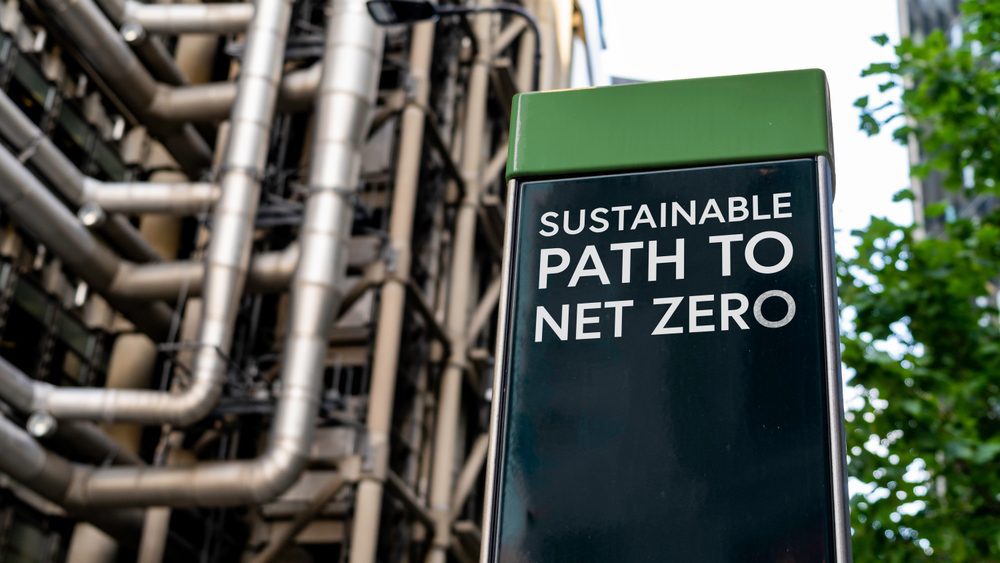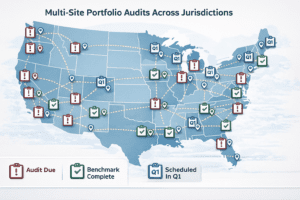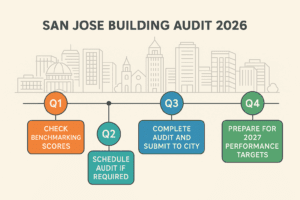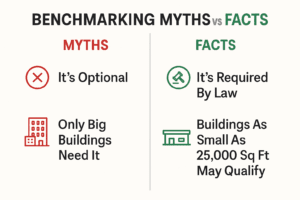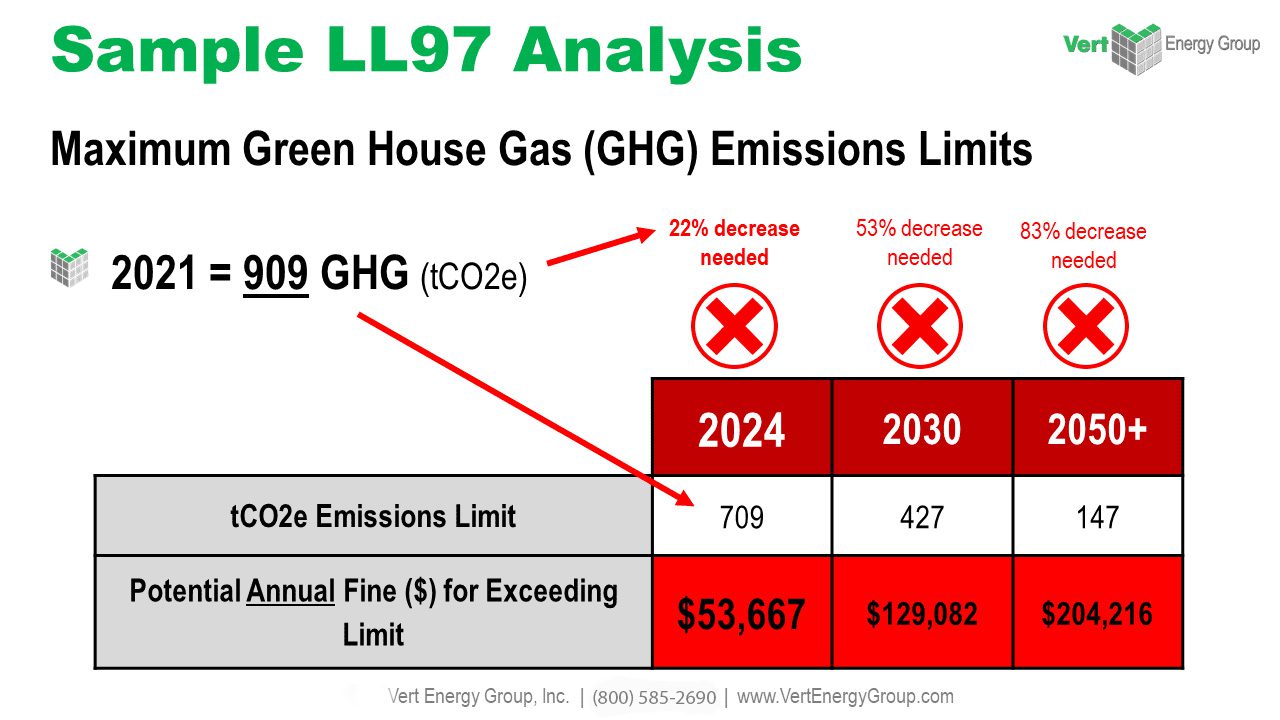Introduction
In the face of growing concerns about climate change and the depletion of natural resources, the need for sustainable and energy-efficient buildings has never been more crucial. Energy benchmarking is a powerful tool that allows building owners and operators to assess and compare their energy performance against industry standards. By identifying areas for improvement, energy benchmarking paves the way for existing buildings to achieve the ambitious goal of net-zero energy consumption. In this article, we will explore the concept of energy benchmarking, its significance for existing buildings, and how it plays a vital role in the journey towards net-zero energy.
Understanding Energy Benchmarking
Energy benchmarking involves the measurement, analysis, and comparison of a building’s energy performance metrics against established standards or similar buildings. The purpose of energy benchmarking is twofold: to understand how a building’s energy usage compares to others in its class and to identify opportunities for energy efficiency improvements. By establishing a baseline, building owners and operators can track their progress over time and make informed decisions to reduce energy consumption.
The Benefits of Energy Benchmarking

Energy benchmarking offers numerous benefits for building owners, operators, and the environment. Firstly, it provides a clear picture of a building’s energy performance and allows for easy comparison with similar buildings. This data-driven approach facilitates the identification of underperforming buildings, enabling targeted energy-saving strategies. For example, if a building’s energy benchmarking results show higher energy consumption compared to similar buildings, it signals the need for investigation and potential energy efficiency upgrades.
Secondly, energy benchmarking promotes transparency and accountability, encouraging building owners to strive for better energy efficiency. When energy benchmarking data is publicly disclosed, it creates a competitive environment where building owners aim to improve their performance and gain recognition for their efforts. This competition drives innovation and fosters a culture of sustainability within the industry.
Additionally, benchmarking can lead to financial savings through reduced utility bills, improved building value, and increased occupant comfort and productivity. By identifying energy inefficiencies, building owners can implement energy-saving measures that not only reduce operational costs but also enhance the overall value of their properties. Energy-efficient buildings often attract tenants who value sustainability, leading to higher occupancy rates and tenant satisfaction.
The Need for Energy Benchmarking in Existing Buildings
Existing buildings pose unique challenges in achieving energy efficiency due to outdated systems, varying levels of maintenance, and structural limitations. However, they also offer significant opportunities for energy savings. According to the U.S. Environmental Protection Agency (EPA), existing buildings account for a substantial portion of the energy consumed globally. Therefore, focusing on energy benchmarking for existing buildings becomes crucial in driving sustainability efforts and reducing carbon emissions.
Energy benchmarking plays a pivotal role in addressing these challenges by highlighting areas of inefficiency and guiding energy-saving investments. By uncovering potential energy-saving opportunities, existing buildings can undergo substantial improvements and move closer to the net-zero energy goal. Energy benchmarking provides building owners with data-driven insights that inform their decision-making process and help prioritize energy efficiency projects. By targeting the areas with the highest energy consumption or the lowest energy performance, building owners can maximize their impact and achieve significant energy savings.
Implementing Energy Benchmarking Programs
To facilitate widespread energy benchmarking adoption, many cities and areas have introduced energy benchmarking programs and regulations. These initiatives often require building owners to report their energy data, creating a comprehensive database for comparison and analysis. Successful programs such as New York City’s Local Law 84 have demonstrated the effectiveness of mandatory benchmarking in driving energy efficiency improvements.
Mandatory benchmarking programs typically establish requirements for reporting energy data, such as utility bills, to a central database. This data is then analyzed to generate performance metrics and ratings for each building. By making this information publicly available, stakeholders can assess the energy performance of buildings and identify areas for improvement. Mandatory programs provide a level playing field, ensuring that all buildings within the area are accountable for their energy consumption and incentivizing energy efficiency upgrades.
For building owners who are not subject to regulatory requirements, voluntary energy benchmarking programs and certifications like ENERGY STAR provide valuable guidance and recognition for their efforts. These programs offer tools and resources to help building owners track their energy performance, compare their buildings to similar ones, and implement energy-saving measures. By participating in voluntary benchmarking programs, building owners can demonstrate their commitment to sustainability and gain recognition for their energy efficiency achievements.
Key Metrics and Data Collection
Accurate data collection is essential for meaningful energy benchmarking. Key energy performance metrics include the Energy Use Intensity (EUI), Energy Star score, and greenhouse gas emissions. EUI represents the amount of energy consumed per square foot of a building’s floor area, allowing for easy comparison between buildings of varied sizes and uses. The Energy Star score, developed by the EPA, provides a standardized rating system that assesses a building’s energy performance on a scale of 1 to 100. Buildings with a score of 75 or higher are eligible for ENERGY STAR certification.
Building owners can collect data through various means, including utility bills, smart meters, and building automation systems. Utility bills contain valuable information about energy consumption and costs, providing a starting point for benchmarking efforts. Smart meters, which record energy usage at regular intervals, offer more granular data and can be integrated into energy management systems. Building automation systems, equipped with sensors and controls, provide real-time data on energy usage, and allow for automated energy-saving strategies.
Leveraging advanced technologies like IoT sensors and energy management software can streamline data collection and analysis, enhancing the accuracy and efficiency of energy benchmarking efforts. IoT sensors can be installed to monitor energy usage in different areas of a building, providing detailed insights into consumption patterns. Energy management software centralizes data collection, automates analysis, and generates comprehensive reports, making it easier for building owners to track their progress and identify energy-saving opportunities.
Analyzing Benchmarking Data
Once benchmarking data is collected, it needs to be analyzed to derive meaningful insights. Performance indicators such as EUI, occupancy patterns, and weather-normalized energy consumption help identify areas for improvement. By comparing a building’s performance against similar buildings or industry standards, trends and anomalies can be detected, leading to targeted energy-saving measures. Analyzing benchmarking data also provides a benchmarking scorecard that visually represents a building’s performance, making it easier for stakeholders to understand and act upon the results.
Benchmarking data analysis can uncover valuable insights, such as identifying energy-intensive systems or operational inefficiencies. For example, by analyzing the energy consumption patterns of a building, it may be discovered that HVAC systems are operating inefficiently or that lighting systems are not utilizing energy-saving technologies. Armed with this knowledge, building owners can prioritize retrofit projects or upgrade to more efficient equipment, resulting in significant energy savings.
Furthermore, benchmarking data analysis allows for the identification of outliers or underperforming buildings within a portfolio. This information enables building owners to focus their resources and attention on the buildings that have the most potential for improvement. By implementing energy-saving measures in these buildings, owners can optimize their investments and achieve substantial energy and cost savings.
Overcoming Challenges in Energy Benchmarking

The implementation of energy benchmarking programs may be difficult due to issues with data privacy, a lack of resources, and ignorance. However, by working together, utilizing available resources, and promoting education and training, all parties may overcome these difficulties.
Data privacy is a significant concern when it comes to energy benchmarking, as building owners need to share energy consumption data for analysis. To address this concern, benchmarking programs and regulations often prioritize data confidentiality and establish strict protocols for data protection. Building owners can also work with trusted third-party providers who have experience in handling sensitive data to ensure that privacy is maintained.
Limited resources, both financial and technical, can hinder the implementation of energy benchmarking programs. However, building owners can leverage existing resources and partnerships to overcome this challenge. Collaborating with local utility companies, government agencies, or energy service providers can provide access to funding programs, technical expertise, and support for energy audits and retrofits. Additionally, engaging with industry associations and networks can help building owners stay updated on the latest trends, technologies, and best practices in energy benchmarking.
Lack of awareness and understanding of the benefits of energy benchmarking can also be a barrier to adoption. Building owners may not be aware of the potential energy and cost savings that can be achieved through benchmarking, or they may underestimate the environmental impact of their buildings. Education and training initiatives can play a crucial role in raising awareness and building capacity. Providing informational resources, organizing workshops and seminars, and sharing success stories and case studies can help building owners and operators understand the value of energy benchmarking and motivate them to act.
Successful Case Studies
Successful case studies from various cities and organizations highlight the potential of energy benchmarking to drive positive change and overcome obstacles. One notable example is the Empire State Building in New York City. Through an extensive energy retrofit program and the implementation of energy benchmarking practices, the iconic building achieved a 38% reduction in energy consumption, resulting in annual energy savings of $4.4 million. This case study demonstrates that energy benchmarking, coupled with targeted energy efficiency measures, can lead to significant financial savings and environmental benefits.
Another inspiring example is the Seattle Municipal Tower. By participating in the City of Seattle’s energy benchmarking program, the building’s energy consumption was reduced by 30% over a five-year period. This achievement was made possible through continuous monitoring and analysis of energy data, identifying areas for improvement, and implementing energy-saving measures.
Conclusion
Energy benchmarking is a crucial step in the path towards energy-efficient and net-zero buildings. By establishing a baseline, analyzing data, and identifying improvement opportunities, energy benchmarking empowers building owners and operators to make informed decisions that lead to reduced energy consumption, financial savings, and a greener future. Whether through mandatory programs or voluntary initiatives, adopting energy benchmarking practices can drive positive change, foster collaboration, and accelerate the transformation of existing buildings towards net-zero energy consumption.
The journey towards net-zero energy buildings is not without its challenges, but with the collective efforts of building owners, operators, policymakers, and stakeholders, it is an achievable goal. By leveraging energy benchmarking as a key tool in the process, existing buildings can transition towards a sustainable future, contributing to global efforts to mitigate climate change and preserve our planet for future generations.
Additional Resources
For further information and resources related to energy benchmarking and net-zero energy buildings, please refer to the following:
– U.S. Environmental Protection Agency’s ENERGY STAR program (www.energystar.gov)
– International Performance Measurement and Verification Protocol (IPMVP) guidelines (www.ipmvp.org)
– Green Building Councils in your region (e.g., USGBC, WorldGBC)
– Local energy efficiency programs and initiatives in your area
If you are looking for an expert Commercial Energy Audit and Benchmark Compliance consultancy, look no further! Contact us at Vertpro.com! We are an award-winning Energy Benchmarking and Audit Consultancy, recognized on Inc. 5000, providing innovative SaaS technology-based solutions for Building Owners & Property Managers to Simplify Energy Compliance with all 50+ Energy Benchmarking & Energy Efficiency Laws Nationwide. From Energy Benchmarking to Energy Audits/RCx Plus and Construction Marketplace, VertPro® has you covered.


